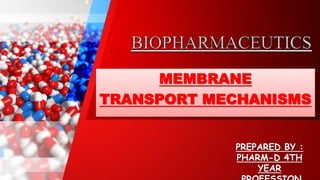
Transport mechanism biopharma
- 1. MEMBRANE TRANSPORT MECHANISMS PREPARED BY : PHARM-D 4TH YEAR
- 3. CELL MEMBRANE Semi permeable membrane. Maintain homeostasis Protection and support for the cell.
- 4. STRUCTURE OF CELL MEMBRANE Double layer of phospholipid. Elastic(7.5-10nm) Contains proteins called membrane proteins Selective permeable LIPID BILAYER: 2 layers of phospholipids Phosphate head is polar (water loving) Fatty acid tails non-polar (water fearing)
- 5. CELL MEMBRANE PROTEINS Integral Proteins Channel Proteins Carrier Proteins Enzyme Proteins Receptor Proteins
- 6. FUNCTIONS OF CELL MEMBRANE Protective function Selective permeability Absorptive function Excretory function Maintenance of shape and size of cell
- 7. TRANSPORT-What it means? Its highly selective filter, permits nutrients leaves the waste products from the cell. Maintain Homeostasis Play an important role in cell to cell communication It detects Chemical messengers arriving at the cell surface.
- 8. TRANSPORT MECHANISMS Active transport Passive transport
- 10. TYPES OF TRANSPORT MECHANISMS Transcellular Vesicellular Paracellular
- 11. ACTIVE TRANSPORT The process needs energy (ATP) for transportation of drug molecules Molecule moves into the cell against its concentration gradient in the lipid bi-layer membrane Transport small particle ions through the membrane i.e. glucose, aminoacids, organic acids and inorganic ions (SO4–, PO4–, K+ etc). Ions movement directly depend on ATP Ions movement does not directly require ATP; energy coupled process
- 12. PRIMARY ACTIVE TRANSPORT In primary active transport, hydrolysis of energy rich molecules such as ATP provide energy required for transport of molecules form lower concentration to higher concentration across membrane.
- 13. SECONDARY ACTIVE TRANSPORT In secondary active transport, one type of molecule migrates from higher concentration to lower concentration, releasing energy. This released energy is used to transport other molecule from its lower concentration to higher concentration across cell membrane Further categorized into three types: Uniport : Moves only one kind of molecule in same direction Symport : Moves different kind of molecule in same direction Anti port :Moves molecule in opposite direction
- 16. PASSIVE TRANSPORT A process that does not require energy to move molecules from a HIGH to LOW concentration Diffusion Facilitated Diffusion Osmosis
- 17. DIFFUSION Diffusion is the movement of small particles across a selectively permeable membrane like the cell membrane until equilibrium is reached. These particles move from an area of high concentration to an area of low concentration. outside of cell inside of cell
- 20. ION PAIR TRANSPORT Drugs which are ionized undr all pH conditions are transported through Ion-Pair transport mechanism. Example: Quateranary Ammonium compound Sulphonic acids Ion pair transport is a passive transport mechanism in which the drug forms a reversible neutral complex with endogenous ion of the GIT, passively diffused through the membrane and reaches systemic circulations. Example: Propanolol is a basic drug that forms a ion pair with oleic acid and absorbed through GIT.
- 22. Facilitated diffusion is a type of passive transport that allows substances to cross membranes with the assistance of special transport proteins. Some molecules and ions such as glucose, sodium ions, and chloride ions are unable to pass through the phospholipid bilayer of cell membranes. Through the use of ion channel proteins and carrier proteins that are embedded in the cell membrane, these substances can be transported into the cell.
- 25. A vesicular transport protein, is a membrane protein that regulates or facilitates the movement of specific molecules across a vesicle's membrane Material move in or out of cell by mean of vesicles Also known as Bulk transport Vesicular Transport Includes: Endocytosis It is a type of active transport that moves particles, such as large molecules, parts of cells, and even whole cells, into a cell. Three Types of Endocytosis includes: 1.Phagocytosis 2.Pinocytosis 3.Recepter mediated endocytosis
- 26. Ingestion of a smaller cell or cell fragment, a microorganism, or foreign particles by means of the local infolding of a cell's membrane
- 27. Condt… Process by which liquid droplets are ingested by living cells. Pinocytosis is one type of endocytosis, the general process by which cells engulf external substances Also called clathrin-mediated endocytosis, is a process by which cells absorb metabolites, hormones, other proteins – and in some cases viruses The specificity results from a receptor-ligand interaction.
- 28. Cell transports secretory products through the cytoplasm to the plasma membrane. Exocytosis occurs when a cell produces substances for export, such as a protein, or when the cell is getting rid of a waste product or a toxin.
- 30. PARACELLULAR PATHWAY It involves the aqueous route of transport. It refers to the transfer of drug by passing through the intracellular spaces between the cells. The cells are joined together via closely fitted junction on other apical side. In general, absorptive epithelia, such as that of small intestine tend be leakier than other epithelia.
- 31. Lipophilicity of drug isn't needed. Avoids drug degradation because of living thing catalyst activity.
- 32. Transport of drug through the pores of biological membrane. The drug molecules dissolve in the aqueous medium at the site of absorption and move along with the solvent through the aqueous pores. Examples of drug that use Paracellular transport is cimetidine, atenolol .urea , water , sugar .